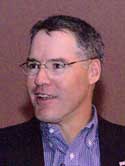
One of the differences between the top one-third and the bottom one-third of producers according to net return is a $98 difference in annual cow costs, said Randy Blach, Cattle-Fax, during Thursday mornings session.
Opportunities for the cow-calf sector
CattleFax’s Randy Blach tells producers to focus on production efficiency and coordinated market efforts to continue capturing profits.
 One of the differences between the top one-third and the bottom one-third of producers according to net return is a $98 difference in annual cow costs, said Randy Blach, Cattle-Fax, during Thursday mornings session. |